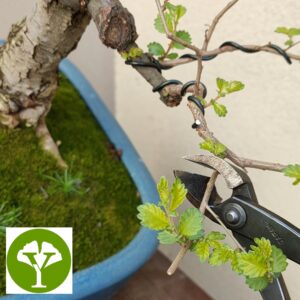The bonsai is a natural tree that, thanks to the skilled hand of the bonsai expert, grows while remaining small. In other words, it is able to increase its ramifications, the total number of its leaves or its needles and to acquire an appearance more and more resembling a tree spontaneously developed in nature, while remaining confined within a pot and maintaining reduced dimensions.
The main technique that allows the branching to develop while remaining small in size is pruning.
The literature on the subject distinguishes two fundamental pruning: formation pruning and maintenance pruning.
- Formation pruning is carried out mainly when the tree is at rest: it is better to do it at the end of dormancy, when the plant begins to swell the new buds in early spring. The main purpose of this pruning is to give shape to the tree by selecting which branches will be the main skeleton of our bonsai. It is no coincidence that training pruning is also called “structure”. If we intervene in the last phase of dormancy we will have a double advantage: we will be able to guess what the “intentions” of the plant are because we will be able to see which and how many buds it is swelling and intervene accordingly; we will also be able to afford the cutting of large branches because we will meet the moment of greatest vigor of our bonsai: spring. The bonsai will therefore be able to heal wounds effectively and quickly. As for the deciduous trees, widely used as bonsai, it is useful to specify that in conjunction with the training pruning it is important to reduce the twigs emitted in the previous season, leaving at least three alternate buds or two pairs of opposite buds. This is also possible in the fall, as soon as the leaves fall.
- Maintenance pruning has done with the aim of maintaining the silhouette of our bonsai, preserving its vigor and making sure that this vigor is well distributed over the whole tree. Depending on the tree species, this type of pruning is performed at different times and with different frequencies. The principle is to allow the branches of our bonsai to extend freely in spring and to intervene only at the end of the extension (generally at the beginning of June) with the complete removal of the branches that tend to be larger, vigorous, long and external to the silhouette; it is also possible to eliminate branches in areas that are overcrowded and that do not allow light to pass to the innermost areas (remember that we want to stimulate the growth of small twigs inside the canopy). Of course, the activity must be done sparingly, to avoid leaving some areas of the plant “uncovered” and therefore weaken it. There are trees that “extend” their branches only once a year, typically those of our latitudes or higher, but there are also trees that continuously extend their hunts, in which case we can repeat the topping operation several times in the year. Instead, we do not recommend partially pruning the branches (leaving some leaves) in order not to weaken them and substantially “lose” them (they may not survive the winter): we postpone this activity to training pruning).
For indoor bonsai, which do not lose their leaves in the winter and work all year round (even if they slow down production in the winter months), it is also possible to prune the long branches with many leaves, leaving at least three at the base of the branch.
Was this article good for you? You can leave a comment or ask a question (Posting will be subject to approval)

